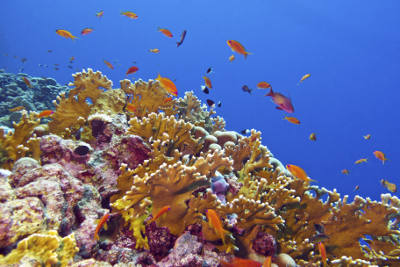River subbasins more depleted than
official figures show
09 April 2024
Published online 15 October 2015
Corals in the Middle East are the perfect model for adaptation to extreme environments. Although research into how they survive is in its infancy, the findings range from promising to fascinating.

© Getty Images/iStockphoto Thinkstock Images
The cause, El Niño, that warms the world’s oceans is a catastrophe for sea life. Its disastrous effects on coral reefs force marine animals and the algae that give them their vibrant colours to part ways, breaking up a symbiotic relationship essential for the corals’ survival; making them wither and eventually die.
The last El Niño event, during 1997-1998, killed about a sixth of all coral colonies worldwide.
By wiping out reef populations, the phase disturbs the food cycles of these tightly-woven ecosystems. Another side-effect is the starvation of different fish species in the aquatic areas most stressed by El Niño, which is expected to last for a few more months. Although the phenomenon hits reefs in the Pacific, Indian and Atlantic oceans, it has a long reach, affecting reefs worldwide.
Amid all the devastation, the unique species of the Middle East are marginally inured to the lethal warmth due to marvellous adaptations.
The reefs of the Persian/Arabian Gulf and the Red Sea have already learned how to survive outside nutrient-rich cold marine ecosystems that their counterparts elsewhere are generally used to.
In fact, these are a type of corals that live in constant warmth all year round.
Because of their robustness in the face of high temperatures and salinity, they have become an object of fascination for the region’s scientists across top research facilities including KAUST and NYADU. The resilience against harsh stressors, is a model of tolerance that some scientists believe can shed light on the solutions to restore and conserve species in other harsh environments – but only if intensively studied and demystified.
In this special Nature Middle East speaks to the researchers leading the vanguard of coral reefs research efforts in the region.
In her feature, Corals get by with a little help from a friend, writer Nadia Al-Awady talks to John Burt and Emily Howells about their thermal stress experiments. Burt speaks of how the biology of reef fauna in the Gulf can provide some incredible insights into how corals and other reef-associated organisms might cope with future climate change. Howells offers clarity on how the symbiotic relationship in this region’s corals is able to survive high summer sea temperatures.
Deeper into the waters of the Middle East lie many hundreds of corals that are perhaps the only contenders to their shallow counterparts in terms of strength and resilience. And Sedeer El-Showk, in his piece Deep Sea corals in the Red Sea: reservoirs of hope, outlines the horizons of research that have opened due to the very existence of these deep-sea corals.
“Corals are very successful evolutionarily. They’ve been here for the last 250 million years,” Chris Voolstra, KAUST researcher, says, debunking the myth that corals are static organisms with poor prospects in the face of climate change.
Corals are very successful evolutionarily. They’ve been here for the last 250 million years.
Moheb Costandi, meanwhile, goes fishing for evidence on how culling top predators in this region, like sharks, is affecting coral reefs. Overfishing threatens Middle East coral reefs considers the struggle over fish as sustenance between corals and man, with the latter exhausting resources that are essential for the stability and biodiversity of the Red Sea ecosystem.
Scientist Michael Berumen says that overfishing has eliminated entire groups of fish from the delicate marine food chain.
Researchers Yi Jin Liew and Manuel Aranda walk us through the epigenetic adaption of corals, sharing their awe at how Rea Sea corals, for instance, thrive under conditions that would not be tolerated by their relatives in other oceans. In an exclusive commentary to Nature Middle East, they explore the adaptive capacities of corals here and consider the question of whether other species may have similar untapped potential.
“Corals have survived several mass extinction events, including the ones that led to the demise of dinosaurs,” they write, going on to reflect on what corals are doing right in terms of genetic adaptation.
Finally, Louise Sarant in Modern taxonomy illuminates the Red Sea delves into the taxonomy methods that scientists rely on to classify coral species – and how eschewing some of the traditional methods is perhaps the only way sometimes to effectively study species in this region.
Berumen and Gustav Pauly, curate for Sarant a variety of regional studies analyzing genetic information about new species and identified the truth about them through novel ways.
Sarant’s essay is accompanied by a blog post on our House of Wisdom that highlights the importance of conservation efforts in the region – the corals’ endurance notwithstanding.
The Red Sea, for instance, will eventually bear the brunt of climate change, and while many of the species are significantly immune to changes in temperatures now, they’re not invincible. The ecosystem can be damaged as temperatures increase, scientists warn.
Although much is yet to be learned about the corals of the region, it is clear their complexity and capability is worth investing time and research as their secrets perhaps hold the key to the survival of their entire marine species.
Corals get by with a little help from a friend
Overfishing threatens Middle East coral reefs
Deep-sea corals in the Red Sea: reservoirs of hope
Modern taxonomy illuminates the Red Sea ecosystem
Epigentic Adaptation of corals: A new hope?
doi:10.1038/nmiddleeast.2015.190
Stay connected: